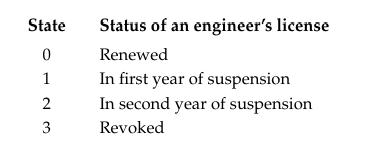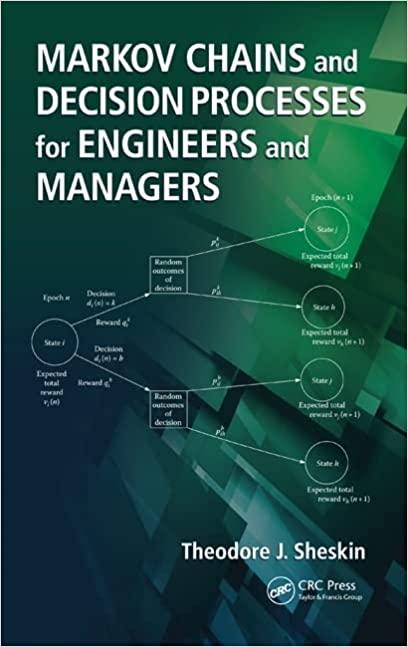Suppose that in a certain state, every licensed professional engineer (P.E.) is required to pass an annual
Question:
Suppose that in a certain state, every licensed professional engineer (P.E.) is required to pass an annual profi ciency test in the practice of engineering in order to renew her license. A P.E. who passes the test has her license renewed for 1 year. A P.E. who fails the test has her license suspended. If a person whose license is suspended passes the test after the fi rst or second year of suspension, her license is restored. However, if a person whose license is suspended fails the test after the second year of suspension, her license is revoked.
Assume that the status of an engineer’s license can be modeled as a four-state absorbing unichain. Let the state Xn be the status of an engineer’s license after the nth annual proficiency test. The four states are identified below:

Suppose that a licensed P.E. has a 0.85 probability of passing the test, and earns \($200\),000 per year as a licensed engineer. An engineer with a suspended P.E. license is employed as an associate engineer at an annual salary of \($120.000\). An engineer whose license is suspended has a 0.65 probability of passing the test on her fi rst try, and a 0.45 probability of passing the test on her second try. An engineer without a P.E. license is employed as an assistant engineer at an annual salary of \($80.000\).
(a) Model the licensure status of an engineer as a four-state absorbing unichain MCR. Construct the transition probability matrix and the reward vector.
(b) Find the expected total reward that a licensed P.E. will earn after 3 years.
(c) Find the expected total reward that a licensed P.E. will earn until her license is revoked.
Suppose that an engineer can increase her likelihood of passing the annual profi ciency test by enrolling in courses of continuing professional development (CPD). The tuition for such courses is \($1\),000 per hour. The recommended annual course loads are 5 h for a licensee, 10 h for an engineer beginning her fi rst year of suspension, and 15 h for an engineer beginning her second year of suspension. By following the recommended annual course loads, an engineer can add 0.10 to each of her probabilities of passing the annual profi ciency test.
(d) If an engineer always follows the recommended annual course loads, model the licensure status of an engineer as a four-state absorbing unichain MCR.
(e) Find the expected total reward that a licensed P.E. who always follows the recommended annual course loads will earn until her license is revoked.
Step by Step Answer:

Markov Chains And Decision Processes For Engineers And Manager
ISBN: 9781420051117
1st Edition
Authors: Theodore J. Sheskin





